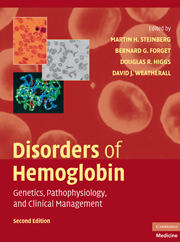Book contents
- Frontmatter
- Contents
- List of Contributors
- Foreword, by H. Franklin Bunn
- Preface
- Introduction, by David J. Weatherall
- SECTION ONE THE MOLECULAR, CELLULAR, AND GENETIC BASIS OF HEMOGLOBIN DISORDERS
- SECTION TWO PATHOPHYSIOLOGY OF HEMOGLOBIN AND ITS DISORDERS
- SECTION THREE α THALASSEMIA
- SECTION FOUR THE β THALASSEMIAS
- SECTION FIVE SICKLE CELL DISEASE
- SECTION SIX OTHER CLINICALLY IMPORTANT DISORDERS OF HEMOGLOBIN
- SECTION SEVEN SPECIAL TOPICS IN HEMOGLOBINOPATHIES
- SECTION EIGHT NEW APPROACHES TO THE TREATMENT OF HEMOGLOBINOPATHIES AND THALASSEMIA
- Index
- Plate section
SECTION ONE - THE MOLECULAR, CELLULAR, AND GENETIC BASIS OF HEMOGLOBIN DISORDERS
Published online by Cambridge University Press: 03 May 2010
- Frontmatter
- Contents
- List of Contributors
- Foreword, by H. Franklin Bunn
- Preface
- Introduction, by David J. Weatherall
- SECTION ONE THE MOLECULAR, CELLULAR, AND GENETIC BASIS OF HEMOGLOBIN DISORDERS
- SECTION TWO PATHOPHYSIOLOGY OF HEMOGLOBIN AND ITS DISORDERS
- SECTION THREE α THALASSEMIA
- SECTION FOUR THE β THALASSEMIAS
- SECTION FIVE SICKLE CELL DISEASE
- SECTION SIX OTHER CLINICALLY IMPORTANT DISORDERS OF HEMOGLOBIN
- SECTION SEVEN SPECIAL TOPICS IN HEMOGLOBINOPATHIES
- SECTION EIGHT NEW APPROACHES TO THE TREATMENT OF HEMOGLOBINOPATHIES AND THALASSEMIA
- Index
- Plate section
Summary
Over the past 30 years we have become familiar with the way in which different types of hemoglobin are expressed at different stages of development. In the human embryo the main hemoglobins include Hb Portland (ζ2γ2), Hb Gower I (ζ2ε2), and Gower II (α2ε2). In the fetus, HbF (α2γ2) predominates and in the adult, HbA (α2β2) makes up the majority of hemoglobin in red cells. These simple facts belie the complexity of the cellular and molecular processes that bring about these beautifully coordinated changes in the patterns of globin gene expression throughout development.
To understand these phenomena we have to consider the individual components including 1) the origins of erythroid cells in development, 2) the processes by which erythroid cells differentiate to mature red cells at each developmental stage, and 3) the molecular events that produce the patterns of gene expression we observe.
Two different types of erythroid cells are observed during development. The first erythroid cells to be seen in the developing embryo are located in the blood islands of the yolk sac. These primitive erythroid cells are morphologically different from the definitive erythroid cells made in the fetal liver and bone marrow and contain predominantly embryonic hemoglobins. Somewhat later during embryonic development, definitive erythroid and other hematopoietic cells originate from multipotent cells identified in a part of the embryo that lies near the dorsal aorta, in the region close to where the kidneys first develop: the so-called aorta-gonads-mesonephros (AGM) region.
- Type
- Chapter
- Information
- Disorders of HemoglobinGenetics, Pathophysiology, and Clinical Management, pp. 1 - 2Publisher: Cambridge University PressPrint publication year: 2009



